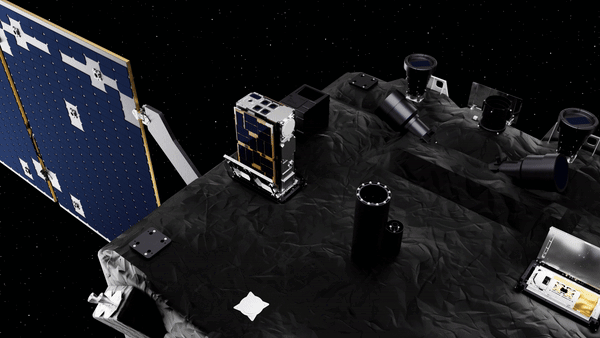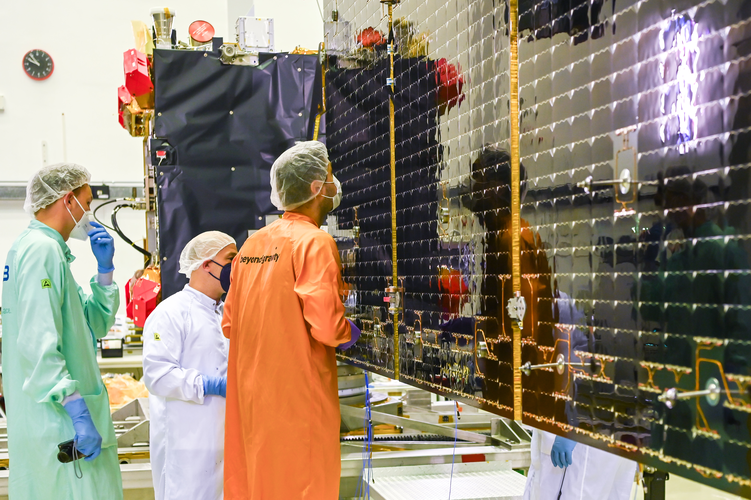Goodbye Hera: asteroid mission departs ESA test centre
After a year of testing, ESA’s Hera asteroid mission for planetary defence is about to depart Europe and head towards its launch site in the USA. The Hera team looked on as the crated spacecraft – along with its twin miniature CubeSats and additional equipment – was driven away from ESA’s ESTEC Test Centre in Noordwijk, the Netherlands.
Following its lift-off this October, after a two-year cruise through space, Hera will rendezvous with the Didymos binary asteroid system: the Dimorphos moonlet, about the size of the Great Pyramid of Giza, is in orbit about 1.2 km away from the mountain-sized Didymos main body.


Access the video
Hera will investigate the altered nature of Dimorphos due to NASA’s DART spacecraft impacting it and shifting its orbit in September 2022. The data returned by Hera will turn this ‘kinetic impact’ method into a well-understood and potentially repeatable planetary defence method.

“This is an emotional moment, after a year of intense testing activity,” comments Paolo Martino, ESA’s lead Hera system engineer.
“It feels like a huge accomplishment to have finally concluded the test process because there is always a lot of tension involved in testing, you never be quite sure everything will go to plan. But the best is yet to come, in the shape of the launch itself.”
The trio of spacecraft were transported overnight to Cologne airport in Germany, where they will be flown to Cape Canaveral in the USA this evening for launch by Space X Falcon 9 in early October.
ESA’s Hera team witnessed the car-sized spacecraft’s departure along with personnel from European Test Services and prime contractor OHB.

Paolo adds: “All of us have been working day and night together since the spacecraft got here in August 2023. To make sure we made the tight schedule every moment had to count, and that meant there were no holidays, no nights off or free weekends. Some of the OHB team have had to spend the whole of the last year away from home."
“Then there have been essential contributions from the companies making our two CubeSats – Tyvak in Italy producing the Milani mineral prospector and Gomspace in Luxembourg responsible for the Juventas radar mapper."


Access the video
“I’d also highlight the work of GMV for the mission’s guidance, navigation and control, OHB Italy for overseeing Hera’s power system, Beyond Gravity for the solar arrays and FHP to dress the spacecraft in its multi-layer insulation, among many others. It has taken a lot of combined effort to reach this moment.”
The accelerated schedule of the whole mission – from contract signing to ready for launch into deep space in only four years – meant that the standard testing simulating the launch and space environments were combined with functional and software testing.

Hera’s last week at ESTEC saw the team packing the Hera spacecraft while completing essential paperwork for shipment – complicated by the fact that while the mission’s supporting equipment will eventually be returned from the USA, Hera and the CubeSats will not.
From this point ESA’s Hera team will be divided. Some will accompany the spacecraft at Cape Canaveral to perform final dry runs and functional tests, while the rest will head to ESA’s European Space Operations Centre in Darmstadt, Germany, where they will assist in Hera’s launch and early operations.

Hera mission manager Ian Carnelli will briefly bid farewell to Hera tonight as it is flown across the Atlantic Ocean aboard a gargantuan Antonov An-124 to Cape Canaveral: “This is a significant departure because the very first version of what would later become the Hera spacecraft was worked on here at ESTEC, at our Concurrent Design Facility, nearly two decades ago. It started life as an observer spacecraft called 'Sancho' that was to complement an asteroid impactor spacecraft ‘Hidalgo’ in ESA’s Don Quijote mission concept, which ended up becoming NASA’s DART."
"It’s been a long journey, but Hera is almost ready to make history!”














 Germany
Germany
 Austria
Austria
 Belgium
Belgium
 Denmark
Denmark
 Spain
Spain
 Estonia
Estonia
 Finland
Finland
 France
France
 Greece
Greece
 Hungary
Hungary
 Ireland
Ireland
 Italy
Italy
 Luxembourg
Luxembourg
 Norway
Norway
 The Netherlands
The Netherlands
 Poland
Poland
 Portugal
Portugal
 Czechia
Czechia
 Romania
Romania
 United Kingdom
United Kingdom
 Slovenia
Slovenia
 Sweden
Sweden
 Switzerland
Switzerland











































